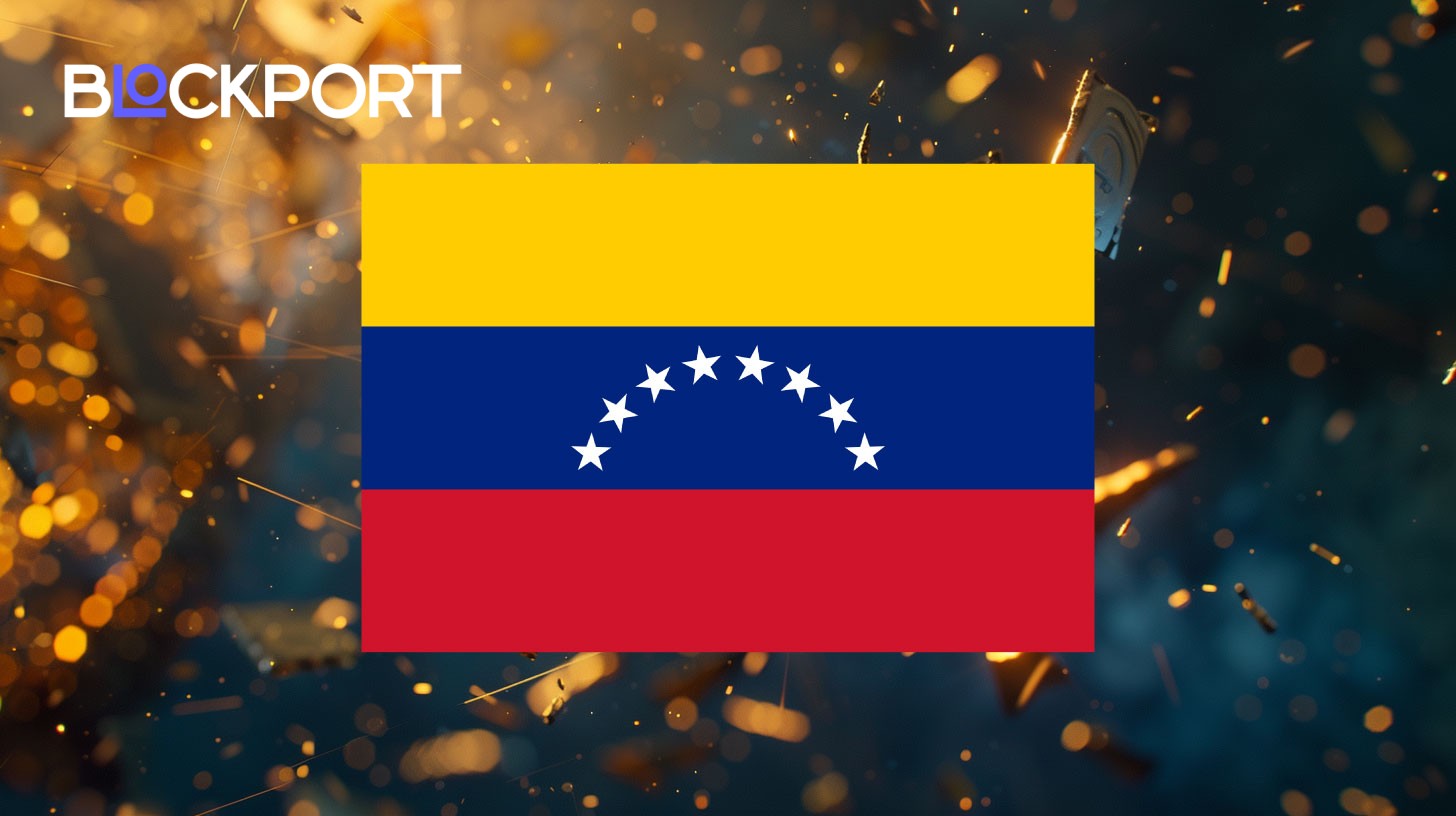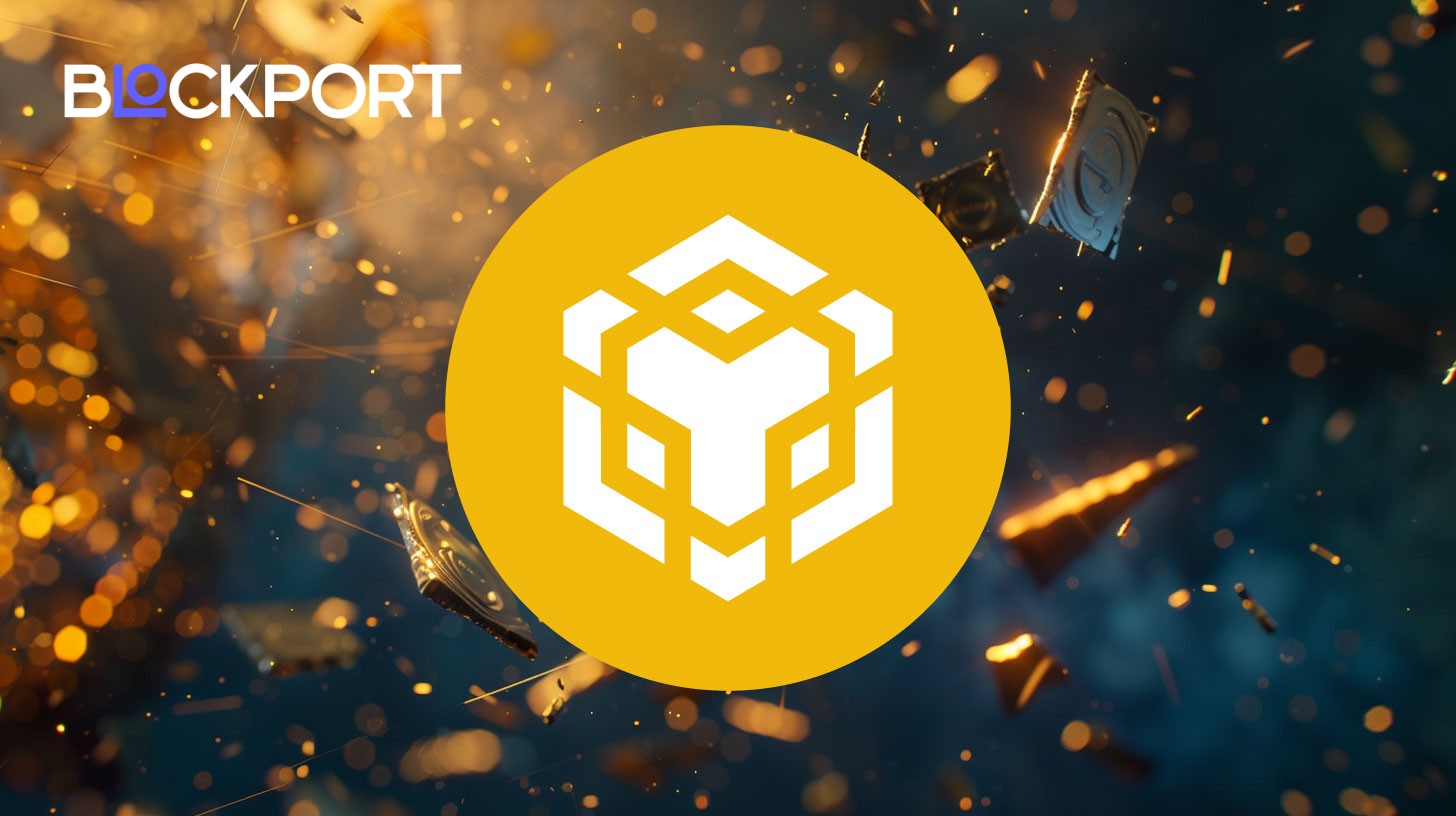ETH to Polygon Bridge: Powering Faster, Cheaper DeFi Transactions

In DeFi, you might sometimes need to bridge Ethereum to Polygon for faster and cheaper transactions across applications.
Blockchains don’t operate in isolation thanks to technology called bridges. These bridges enable communication between different networks, allowing users to move assets, interact with dApps, avoid high fees, and complete transactions faster.
In this article, we’ll take a closer look at how to bridge ETH to Polygon and when this is useful.
What You Should Know About the Polygon Network
Polygon is one of the largest blockchain ecosystems. It was launched in 2017 under the name Matic Network and later rebranded to Polygon. Its native token, POL (formerly MATIC), is used for payments, staking, and governance.
Polygon offers a suite of scaling solutions for Ethereum, aimed at improving its speed and cost-efficiency through various protocols that work with Ethereum. Among these are Polygon PoS (the original Polygon chain) and Polygon zkEVM. The latter is a Layer 2 scaling solution that uses zero-knowledge proof technology to batch transactions and validate data, enabling fast transactions with minimal gas fees. Polygon PoS is like a separate highway that runs alongside Ethereum – it’s faster and cheaper but uses its own security guards. Polygon zkEVM is more like an express lane on Ethereum itself – it inherits all of Ethereum’s security but processes transactions much faster.
Polygon users and developers can move assets from Ethereum to both Polygon PoS and Polygon zkEVM using Polygon bridges. According to DefiLlama, a total of over $5.7 billion in assets have been bridged to Polygon, with USDT and USDC stablecoins being the most frequently transferred.
ETH to Polygon: Bridging Infrastructure Explained
Starting from the basics, the ETH to Polygon bridge is a type of cross-chain bridge that allows moving tokens between these networks. For example, when most of your funds are on the Ethereum mainnet but you use dApps on Polygon, it makes sense to bridge the assets.
Bridging between Ethereum and Polygon is possible through two primary avenues: native infrastructure provided by the Polygon team and third-party bridging tools, including Across Protocol, Symbiosis Finance, Synapse Protocol, Orbiter Finance, and others. It’s important to note that you can move Ethereum-native tokens to Polygon. For tokens on other chains, you’d need to use other bridging solutions, like ETH to Solana or ETH to the BNB Chain bridges.
When you bridge ETH to Polygon POS, think of it like exchanging dollars for casino chips. Your real ETH stays locked in a vault on Ethereum, and you get WETH tokens on Polygon that represent the same value. Conversely, when you bridge tokens back from Polygon POS to Ethereum (e.g., burning WETH on Polygon), the corresponding original ETH is unlocked on the Ethereum side.
Polygon zkEVM, on the other hand, is designed to be EVM-equivalent. A big difference from Polygon PoS is that ETH is the native gas token on Polygon zkEVM. This means you’ll use the bridged ETH directly to pay for transaction fees on Polygon zkEVM, just like you would on Ethereum mainnet.
On Polygon PoS: You get WETH tokens (representing your ETH) and use POL tokens to pay fees.
On Polygon zkEVM: Your ETH works exactly like it does on Ethereum – same token, same fees, just faster and cheaper.
If you’re wondering how to bridge MATIC from ETH to Polygon, the process typically involves locking MATIC on Ethereum and minting an equivalent amount on Polygon.
Whether using native or third-party solutions, the ETH to Polygon bridge relies on tools and underlying protocols, including crypto wallets, smart contracts, and a network of validators.
Step-by-Step Guide to Bridging Ethereum to Polygon
Here, we’ll look at how to bridge ETH to Polygon using Polygon’s native bridge mechanism.
Step 1: Go to the Polygon Portal and Click “Bridge your Asset.” On the screen, you’ll see drop-down options to select the chain you’re moving assets from, the asset you want to transfer, the amount, and the destination Polygon chain – either Polygon PoS or Polygon zkEVM.
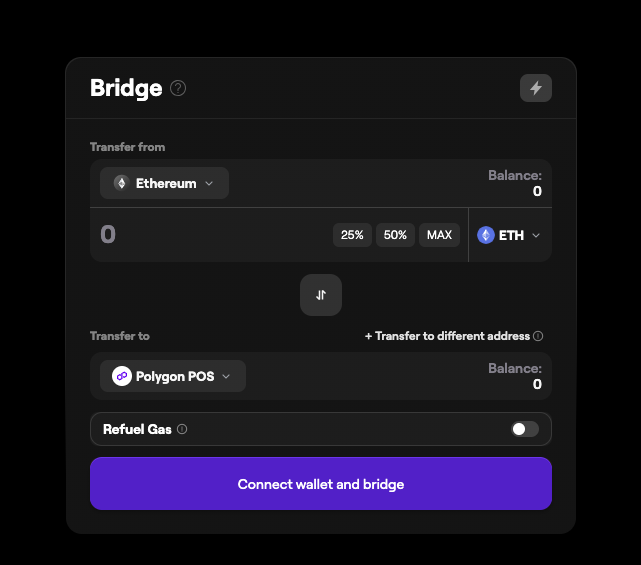
Step 2: Click the “Connect Wallet” button in the top-right corner of the page. Then, select your wallet from the list of supported options. The Polygon Portal supports over 460 wallets, including MetaMask, Trust Wallet, Zerion, SafePal, and others. You’ll be asked to approve the wallet connection. In this example, we’re using MetaMask as part of the Ethereum to Polygon bridge process to transfer ETH to the Polygon network.
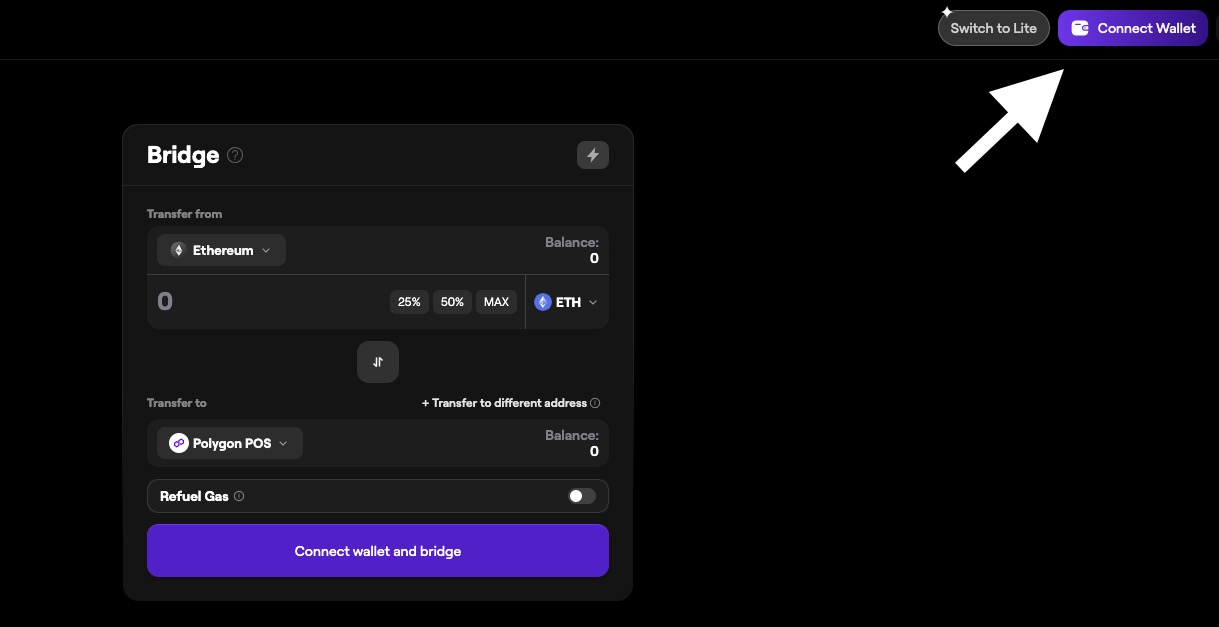
Step 3: Input the necessary information for the transaction. In this step, you initiate the transaction by filling in the required fields and reviewing the estimated time and gas fees. Compare transfers to Polygon PoS and Polygon zkEVM to choose the option that better meets your needs.
Bridging Ethereum to Polygon POS
As you can see, we selected 0.1 ETH (around $340 at the time of writing) to transfer from Ethereum to Polygon. The estimated transaction time was around 22 minutes, with a projected cost of $8.89. It’s important to note that initial estimates are often not accurate. After clicking “Bridge,” you’ll see the actual transaction details to approve, including the final network fee and timing. In our case, the real network fee at the time of confirmation was $3.08, and the transaction completed in about 12 seconds. A network fee alert also appeared, noting that gas prices were volatile, making the estimates less reliable.
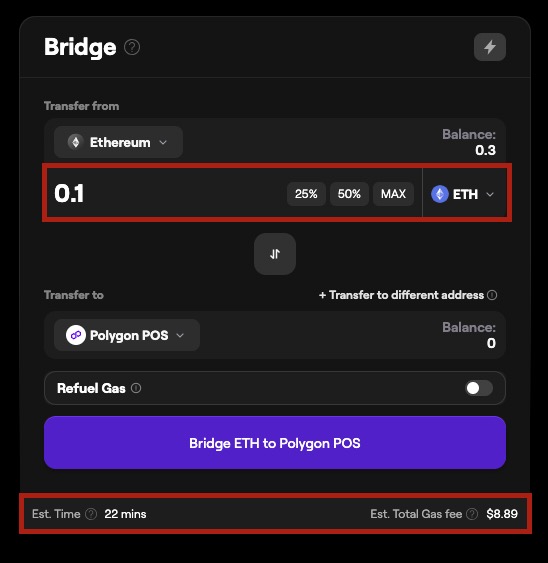
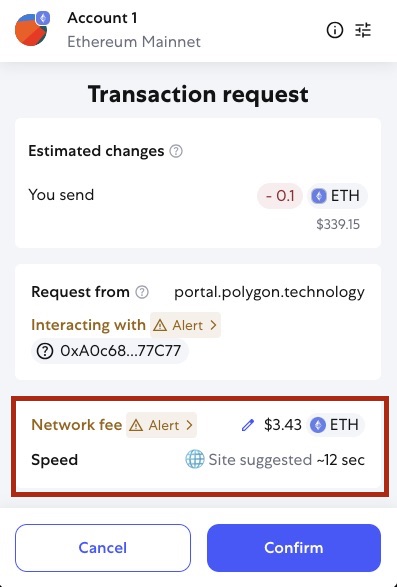
Bridging Ethereum to Polygon zkEVM
To compare the two bridging options, we selected the same 0.1 ETH amount for transfer from Ethereum to Polygon zkEVM. Based on the initial estimate, the transaction would cost around $6 and take about 20 minutes. However, after clicking “Bridge,” the estimated fee was just over $3.56 – interestingly close to the fee on PoS – and the suggested processing time was also similar: around 12 seconds.
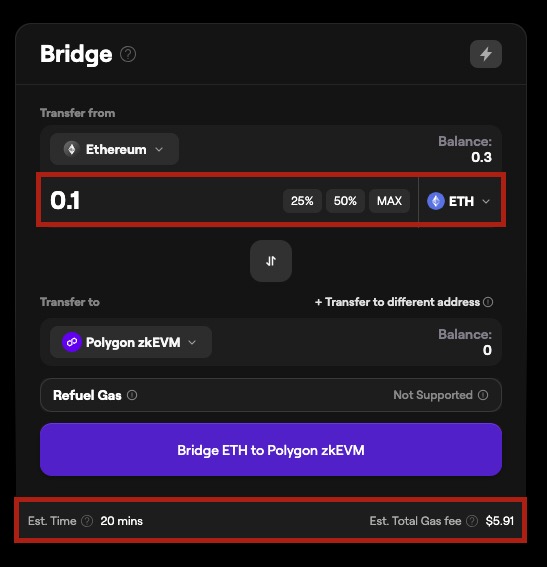
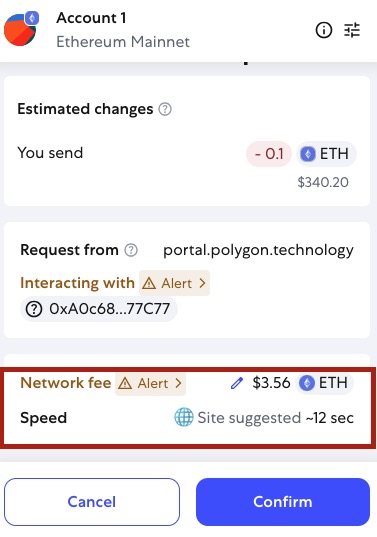
Step 4: Confirm the transaction: After you choose how many tokens to bridge and check the fees, click “Confirm.” Your tokens will then be sent to Polygon.
What Are the Advantages of Using Polygon for ETH?
Polygon offers a solution to Ethereum’s common issues: high transaction costs and slower speeds. It significantly reduces fees, often to just a few cents, making even small transactions practical. Transactions also confirm much faster, typically within seconds. This efficiency allows for a more active and affordable experience across DeFi, gaming, and NFTs. The ability to bridge ETH to Polygon is key, letting users seamlessly move assets and leverage these benefits without sacrificing Ethereum’s foundational security.
Content on BlockPort is provided for informational purposes only and does not constitute financial guidance.
We strive to ensure the accuracy and relevance of the information we share, but we do not guarantee that all content is complete, error-free, or up to date. BlockPort disclaims any liability for losses, mistakes, or actions taken based on the material found on this site.
Always conduct your own research before making financial decisions and consider consulting with a licensed advisor.
For further details, please review our Terms of Use, Privacy Policy, and Disclaimer.











